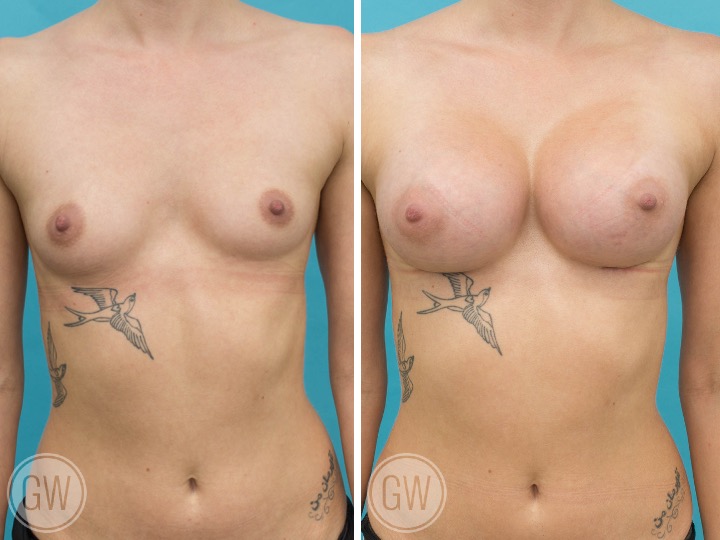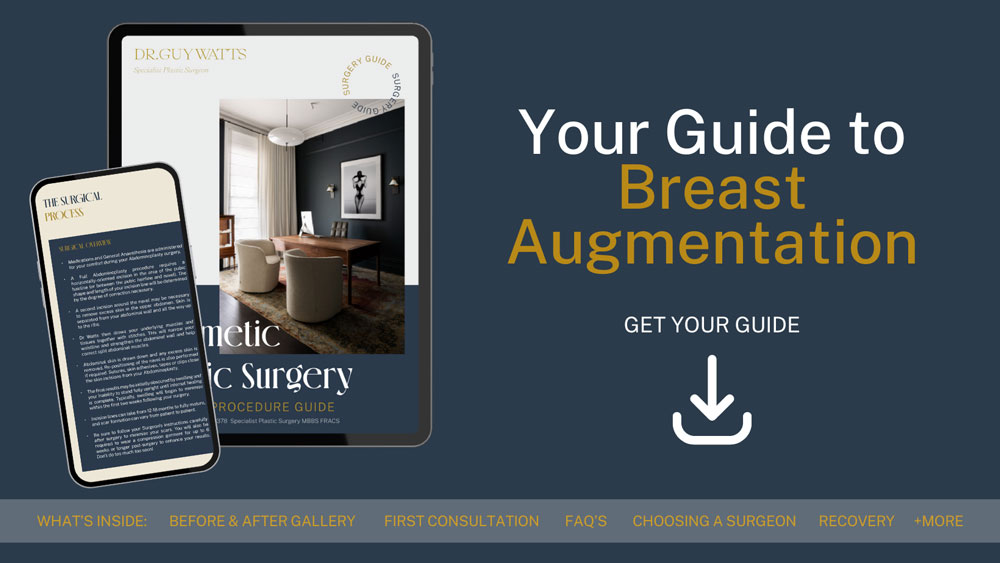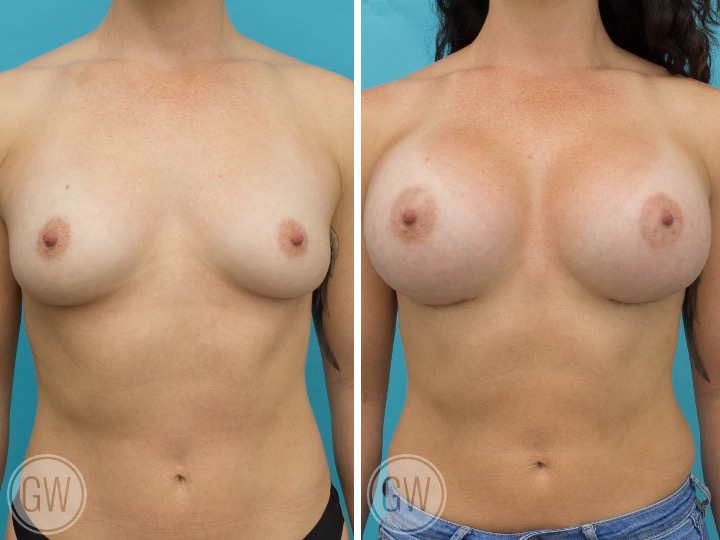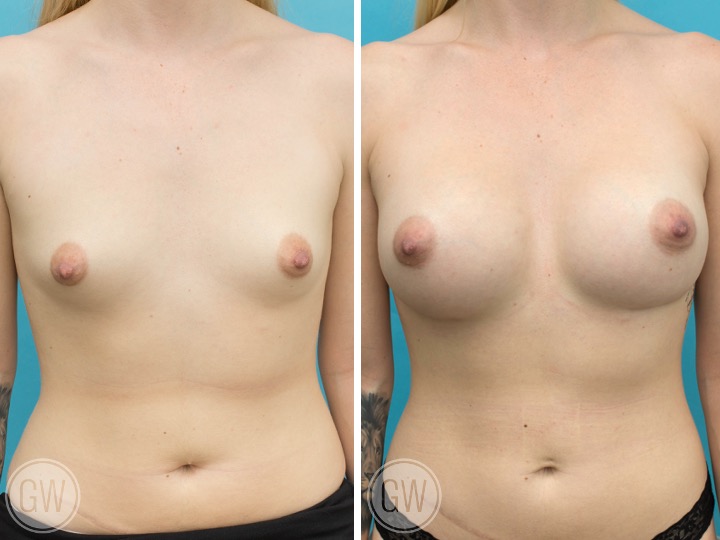
22 Aug How to Choose your Breast Implant Size
Choosing the right breast implant size is not just a matter of aesthetics – it involves careful consideration of anatomy, lifestyle, long-term health, and realistic outcomes. Patients benefit from expert guidance when making such a personal and medically significant decision.
Dr Guy Watts, a Specialist Plastic & Reconstructive Surgeon based in Perth, Western Australia, takes a tailored approach to every consultation. His clinic offers comprehensive assessments that help patients make informed decisions based on measurable data and individual goals. This article outlines the key considerations and clinical insights involved in selecting the best breast implant size.
Take our quiz, and find out if you are ready for surgery
Why Breast Implant Size Matters
Breast implant size is a critical factor in determining the final appearance and feel of the augmented breast. The size not only influences volume but also affects the relationship between the implant and the chest wall, the tension on the skin, and the long-term stability of the breast shape.
Choosing the correct size:
- Enhances proportion between the upper body and hips, helping patients achieve balanced results that align with their frame.
- Reduces physical discomfort by avoiding overly heavy implants that could place strain on the neck, shoulders, or back.
- Supports healthy tissue maintenance, as excessive implant weight or width can cause stretching of the skin, downward migration of the implant (commonly referred to as “bottoming out”), or thinning of the overlying breast tissue.
- Plays a role in ageing outcomes, as a size too large for a patient’s anatomy may accelerate sagging or result in the need for earlier revision surgery.
In his Perth-based practice, Dr Guy Watts provides patients with the knowledge and support needed to prioritise both appearance and health when selecting an implant size.
Key Factors That Influence Implant Size Selection
Each patient brings a unique anatomical structure, lifestyle, and set of expectations to their breast augmentation journey. Selecting the right implant size requires understanding and balancing several interrelated factors.
✓ Chest Dimensions and Frame
The foundation of implant sizing begins with a detailed assessment of the patient’s chest dimensions. This includes:
- The width of the breast base, which determines how wide an implant can be without extending beyond the natural boundaries of the breast.
- The sternal width or distance between the breasts, which affects how implants appear when viewed from the front.
- The overall shoulder-to-hip ratio, which helps ensure that the selected implant maintains aesthetic balance with the rest of the body.
- The chest wall shape, including whether it is flat, convex, or concave, which can subtly affect how the implant projects forward.
Incorporating these anatomical markers into implant selection ensures that the final outcome feels proportionate and avoids crowding or excessive lateral fullness.
✓ Skin Quality and Breast Tissue
Skin elasticity and the thickness of existing breast tissue influence the body’s ability to accommodate an implant comfortably. During the consultation:
- Elastic, resilient skin can more easily adapt to volume changes and helps maintain implant support over time.
- Thinner or stretched skin, often seen after weight loss, pregnancy, or ageing, may limit how much volume can be safely introduced.
- Existing breast tissue volume will also contribute to the final look, especially in patients opting for smaller implants or seeking subtle enhancements.
- Asymmetry – a natural variation between breasts – is also considered, and occasionally two different implant sizes are recommended to achieve symmetry.
Dr Guy Watts uses tactile assessments and measurements to ensure implant sizing supports tissue longevity and aesthetic goals.
✓ Desired Appearance
Each patient has a personal vision of what they hope to achieve, and these preferences must be translated into clinical choices:
- Some patients may request a fuller upper pole, resulting in a rounder or more projected look.
- Others prefer a gentle slope and natural contour, especially if aiming for subtle enhancement or restoration of volume after pregnancy or breastfeeding.
- Visual aids and sample implants help patients understand what various sizes and profiles will look like when placed under or over the muscle.
By taking time to understand your preferences and aligning them with anatomical considerations, Dr Watts creates outcomes that are both visually appealing and physically appropriate.
✓ Lifestyle and Physical Activity
The right implant should not interfere with your daily life. In fact, lifestyle considerations are often the deciding factor when choosing between otherwise suitable sizes:
- High-impact athletes, such as runners, swimmers, or dancers, may benefit from lighter or smaller implants that reduce bounce and strain.
- Professionals in physically demanding roles, including nursing or construction, might prioritise comfort, minimising the impact of implant weight during physical labour.
- Parents or caregivers may need implants that allow unrestricted movement when lifting children or engaging in other regular physical tasks.
- For patients planning future pregnancies, it’s important to discuss how weight fluctuations and breastfeeding could affect implant appearance over time.
All of these lifestyle insights are incorporated into the treatment planning process at Dr Watts’ Perth clinic.
DOWNLOAD DR WATTS’ GUIDE TO BREAST AUGMENTATION

Implant Profiles and Projections Explained
Implant “profile” refers to how far the implant projects outward from the chest wall. Two implants may have the same volume but differ significantly in shape and forward projection due to profile selection.
Profile Options:
- Low profile implants are broad and flat, offering minimal projection. These are often suitable for wider chest walls or for those desiring subtle enhancement.
- Moderate profile implants offer a balanced combination of width and projection. They are commonly used in a variety of patient body types and aim to create a natural appearance.
- High profile implants are narrow at the base but project more prominently. They can be selected to increase fullness, particularly in the upper portion of the breast, but must be carefully chosen to avoid exaggerated results.
Choosing the right profile is just as important as choosing the right size in cc. In his consultations, Dr Guy Watts offers detailed comparisons and allows patients to feel and visualise the difference between profiles.
The Role of Consultation in Decision-Making
The pre-operative consultation is more than a discussion – it is a critical planning session that informs every aspect of surgical care. In Perth, Dr Guy Watts delivers thorough, one-on-one consultations that cover:
- Detailed anatomical measurements, including base width, nipple position, and skin fold distance, to inform implant volume and profile.
- Use of imaging tools, such as 3D simulations, to preview different implant sizes and shapes directly on the patient’s image.
- Trial with sizing bras or sizers, which allows patients to physically feel what different volumes may be like under clothing.
- A thorough medical history review, ensuring there are no underlying factors that could affect the choice of implant or surgical plan.
This collaborative process empowers patients and ensures that their choice is not only aesthetically satisfying but medically safe.
Balancing Expectations with Realistic Outcomes
The desire for enhancement must be matched with respect for the body’s limits. While some patients may envision a dramatic change, it’s essential to weigh those desires against the potential effects on breast tissue, skin, and overall function.
Realistic planning helps:
- Minimise post-surgical complications, including stretching, sagging, or thinning of tissue that can arise from overly large implants.
- Preserve breast support, particularly for patients with active lifestyles or weaker skin tone.
- Reduce the need for future revision surgery, by selecting a size that ages well and adapts to natural changes in the body.
- Achieve lasting satisfaction, as proportionate, anatomically matched implants tend to retain a pleasing appearance longer.
Dr Guy Watts brings years of surgical expertise and clinical insight to this process, ensuring that each recommendation is informed by both patient goals and sound surgical judgement.
FAQs About Choosing Breast Implant Size
Why Consult Dr Guy Watts in Perth?
When it comes to choosing a breast implant size, experience matters. Dr Guy Watts, a Specialist Plastic & Reconstructive Surgeon, offers a balanced, evidence-informed approach that empowers patients to make informed decisions with confidence.
His Perth clinic is equipped with modern imaging tools, surgical planning software, and a calm, welcoming environment designed to facilitate thoughtful discussions. His philosophy is grounded in anatomical accuracy, patient education, and long-term wellbeing.
Whether you’re considering breast augmentation for aesthetic refinement, reconstruction after surgery, or volume restoration, Dr Watts will support you with clinical excellence and patient-centred care at every step of your journey.
Further Reading
- Read more about Guy Watts’ blog on Choosing the Right Breast Implant Shape For You – Round Vs Teardrop
- Read more about Guy Watts’ blog on What Are the Most Subtle Looking Breast Implants?
- Read more about Guy Watts’ blog on Different Types of Silicone Breast Implants
About Dr. Guy Watts – MED0001539378
FRACS (Plas) – Specialist Plastic Surgeon In Perth WA
Dr. Guy Watts is a Specialist Plastic Surgeon (AHPRA MED0001539378) with an extensive career that spans across renowned plastic surgery clinics worldwide. His experience has been honed through invaluable experiences at esteemed establishments such as the New York Eye and Ear Infirmary and the renowned Pitanguy Clinic in Brazil.
Having collaborated with the foremost cosmetic plastic surgeons on a global scale, Dr. Watts has chosen to return to Perth after a 17-year journey of intensive training and invaluable professional experience to bring the latest practices and technology in cosmetic plastic surgery to his patients.
Dr. Watts is a Fellow of the Royal Australasian College of Surgeons (FRACS) and a Member of the Australian Society of Plastic Surgeons (ASPS), Australasian Society of Aesthetic Plastic Surgeons (ASAPS) and the International Society of Aesthetic Plastic Surgeons (ISAPS).
Read about the potential Risks and Complications of Surgery
Read the Patient Information and Resources
About CLINISPA
Clinispa is Dr Watts’ bespoke medical clinic performing Cosmetic Aesthetic treatments. At Clinispa, we offer advanced clinical treatments in a luxurious and calming environment, tailored to support your skin’s health and appearance.
Clinispa aesthetic services are performed by Dr Guy Watts’ nursing professionals, who have a passion for and solid understanding of facial aesthetics.
All Clinispa clients are considered individually, with a personalised treatment plan consisting of advanced scientific approaches to cosmetic aesthetics. We incorporate innovative technologies in conjunction with superiorly formulated skin care.
For more information about the full range of Clinispa Aesthetic of Cosmetic Treatments visit the Clinispa website










Sorry, the comment form is closed at this time.